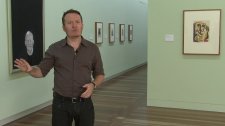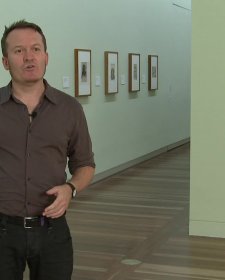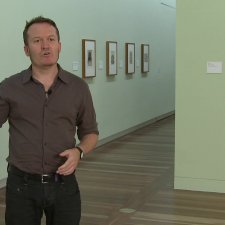Lesley : In 1943, Melbourne artist Albert Tucker began a new phase in his art. Recently discharged from the army and primed with a fresh vocabulary of imagery that drew on the breadth of his wartime experiences, he commenced his iconic Images of Modern Evil series, some 39 paintings made over a six-year timeframe. It is the body of work for which he is now best known, and which helped secure his notoriety as a painter of the dark side of the human condition.
So the first image that you saw was actually the first painting in the Images of Modern Evil series painted in 1943 called Spring in Fitzroy. And this is another early work from the series.
Though perhaps less notorious in the popular imagination, the Images of Modern Evil nonetheless holds its own as a companion series to Sidney Nolan’s eponymous Kelly suite, or at least as its counterpoint. While Nolan took Australian history and nature and presented Kelly as a type of Australian everyman within it, Tucker dealt instead with human drama and universal fears and desires, using the familiar streets of Melbourne during the blackout as his stage. As Tucker noted – and he’s talking here about the kind of iconic imagery that came out of both of these series – they both had an abstract form, which was a personal one in both cases. With me it was in the urban expressionist setting, whereas with Nolan it was set in the bush lyrical setting. And I think in some ways that little quote just sums up how Tucker felt about the kind of advancements that they were making with these two really very significant series, which I think very much stands as a milestone and a transition point in the way that modernism took its course in Australia.
Some years ago we mounted an exhibition at Heide Museum of Modern Art that critically examined the role of portraiture in the burgeoning modernism of the Heide Circle artists. We claimed that their evolving artistic identities were affirmed in portraits and self-portraits which were painted concurrently with their more socially informed series. Although none were professional portrait painters, artists like Albert Tucker, Sidney Nolan, Joy Hester, Arthur Boyd, John Perceval, and Danila Vassilieff, all turned to portraiture during their formative years. The portraits operated as an index of their new endeavours and as a corollary to their groundbreaking practice, while offering an interlude from these new works.
With the advent of modernism, the conventional modes of portraiture were challenged and transformed, providing a familiar format in which ideas and techniques could be tested and consolidated. They were mostly not commissioned, but painted in an informal conversational manner evolving from personal and domestic exchanges, and often conveying an intimacy that locates them within the fabric of everyday life. Tucker’s portraits until this time relied on physiology and likeness rather than modernist mediation. His portrait of artist and commentator, art commentator and friend, Adrian Lawlor, is a case in point.
This 1939 portrait relates closely to a sequence of photographs Tucker took on a sunny day outside Lawlor’s stark white modernist house in Warrandyte, an incongruous intervention built in the thick bush near the Yarra River in outer Melbourne following the razing of his previous home in the Black Friday bushfires in that same year. Lawlor had a quick wit and a fierce intellect, and his knowledge of art and devil-may-care attitude appealed to Tucker’s anarchic tendencies. He also had a very distinctive appearance.
Though by now Tucker was interested in modernist trends overseas and reading widely on the avant-garde art of Europe, this portrait remains an enigmatic statement. Particularities of Lawlor’s features are emulated and slightly exaggerated in Tucker’s 1939 portrait, and perhaps there is a little of his personality; but for all its accomplishment, Tucker had as yet not found a way to combine physical likeness and psychological particularity, the seen and unseen aspects of the human subject.
Tucker had been exhibiting professionally for only five years when this painting was completed, yet he was on the cusp of his major breakthrough, which he identified as tapping into the creative territory of the unconscious and the instinct rather than the world of mediated objectivity. He was interested in allowing what he understood as an older personality to surface, one that usually lies buried in the deeper recesses of the mind, that is probably with us all the time but is suppressed.
Born in 1914, Tucker left school at 14 to work as a commercial artist. His art education, however, was largely self-directed. Some Saturday classes at the George Bell School helped focus his early talent, and seven years of life drawing at the Victorian Artists Society with a model but no formal instruction honed his technical skills. His immediate peer group centred around John and Sunday Reed’s circle of artists, writers, musicians, and intelligentsia at Heide, provided intellectual engagement and a forum for debate, encouraging him to read, question, risk, and develop; and this he did with alacrity between the late 1930’s and his service in the army in 1942, a period of personal and professional trial and growth during which he found a way to connect his deepening interests in art, psychology, myth and symbolism.
The fundamental shift in his art, in the way he wished to penetrate beneath the surface appearance of his subjects and investigate the outer and inner image of them, pivots on the paintings and specifically the portraits that he created during his service in the army in 1942.
Albert Tucker’s pictures of wounded and psychologically damaged soldiers are, I think, among the most startling and potent images to emerge from the World War II era of Australian art. They are characterised by a fixation in psychiatric conditions and extremes of social dislocation, and they mark a transition in Tucker’s art whereby he no longer sought to represent merely the world of visual appearances, but found a way to relate the mood of despair and anxiety that accompany this period in Australia’s history.
These images also belong more generally to a period of growing fascination with the psychological dimension of modern life, a predilection that helped clarify and separate the intensions of the so-called Angry Penguins group of artists, including Nolan, Hester, Perceval, Boyd, as well as Tucker, from those of their contemporaries.
Tucker’s mobilisation was brief, just eight months in duration; yet the experience and the art he produced during that year, the psycho-portraits as he described them, provided him with a wellspring of ideas and new methodologies. Tucker objected to the war, though, less as a pacifist than as a reluctant soldier. Like many others, he thought it was Europe’s conflict, not Australia’s. He was called up in 1940 and proceeded to do everything he could to avoid going into the army. He visited esteemed psychiatrist Dr Reginald Ellery in an attempt to gain medical support for a reprieve.
Ellery was an expert on the psychiatric impact of war. Outspoken and antifascist, he was deeply concerned about modern warfare’s social implications and the prolonged disturbance to normal conditions to be weathered in its aftermath. Ellery knew Tucker through their mutual acquaintance with art patrons John and Sunday Reed, and acceded to Tucker’s request, noting him as the cyclothymic type. Tucker was by his own admission raving on at the meeting, and the doctor seemed amenable to the idea of declaring him unfit for service. Just to be sure, as married men at that stage could avoid conscription, he fast-tracked his nuptials with artist Joy Hester and their union was formalised on the 1st of January, 1941. A second call-up that year saw him confirmed as perfectly fit and able, which of course he was; he was just a very anxious man, I think. Tucker immediately cut all connections with his residence and studio in Little Collins Street in Melbourne and effectively disappeared for several months, living in a series of short-term accommodations and sleeping on people’s couches and, more unfortunately, in a state of self-imposed but unabated anxiety.
Once war broke in the Pacific and the Japanese were on Australia’s doorstep at the close of 1941, however, he changed his mind. The following April, he was posted to Wangaratta Training Camp in northeast Victoria. The camp’s conditions were unpleasant, and Tucker quickly found them intolerable. He had rats running over him while he slept; the food was unpalatable; and he was frequently sick and unable to attend to his duties. So he sought an opportunity to transfer. He later reported that he was in fact sent to the hospital, at the Heidelberg Military Hospital, by an empathetic superior, and that his chronic infirmity was largely psychosomatic.
So he was posted or sent to Heidelberg Hospital in Melbourne’s north-eastern suburbs, which was close to Heide where Hester was staying in his absence. Once there, he – and this is a photo, as you can see, of Tucker briefly on leave, in his uniform, with Joy Hester at Heide – once there, he worked with the plastic surgery unit and was exposed to men bearing a litany of injuries to both body and mind. Among those requiring skin grafts and corrective surgery, Tucker was particularly moved by a soldier whose nose had been sliced off flush against his face by a shell fragment, recalling that while he was drawing all the nasal cavities the soldier had a continuous stream of phlegm pouring down his face. This image imprinted itself on Tucker’s mind, and the sliced nose featured regularly in his paintings for the next decade, a summary form or symbol for human frailty and looming psychosis. Got a few examples of sort of different formats of that sliced nose appearing as part of his imagery, and some most notoriously I think in the Victory Girls painting of, it’s actually 1940, it is 1943. And the Totem painting is possibly, it’s very similar to a self-portrait that Tucker painted that same year, so it has a similar sort of format. And it’s not beyond Tucker to include himself in his pictures, as you’ll see a little later on.
Tucker was as deeply affected by patients suffering from mental disorders and undergoing seemingly primitive forms of therapy then meted out by the army. According to Tucker, the tremulous shell-shocked soldiers or bomb-happies whose nervous systems had been shattered in combat were injected with enough insulin this morning to render them almost comatose. Upon emerging from this state, they were fed a special lunch, after which the twitching and the quivering would subside until the next day, when the process would be repeated. I’m not entirely sure how accurate this story is, but it’s one that Tucker repeated in several interviews later on. It’s the way that he recalls the treatment occurring.
They were also subjected to a regular dose of RAAF planes flying and dying overhead. Thought this would initially have the patients terrified and screaming, hiding under the beds and trying to run up the walls, after a time their panic started to dissipate and they become accustomed to the noise and its associations, their senses reprogrammed.
Tucker’s own mental state, sullied by his precarious and anxious circumstances in the lead-up to enlistment, may well have contributed to the acceleration in his artistic development during 1942. He later admitted, “I went through all the usual feelings: a grievous sense of injustice and that life was out to get me, which on one level it was. I was in a state of outrage and frustration. Yet these, the very things that traumatised me, forced insights that I would never have acquired in any other way.” He maintained, “This was the thing that forces the real growth in that area below our level of awareness, underneath consciousness.”
The works that resulted from this intense period for Tucker can be more or less divided into two groups: those that respond to the physical and psychological consequences of war, as a type of subjective documentary, and those that extend the subject into the existential realm, signifying themes of despair, isolation, alienation, and insanity. The former group operates more consciously as reportage, and is mitigated by dual frameworks of personal discontent and political beliefs. The latter resounds with Tucker’s literary and theoretical interests, poetry and fiction, including TS Eliot’s The Wasteland, Arthur Rimbaud’s A Season of Hell, and Stephen Spender’s The Destructive Element, an analytical study of individualist writers concerned with moral and political life, through to revelations on the psyche found by way of Viktor Lowenfeld’s book The Nature of Creative Activity, Reg Ellery’s Theories on War and Irrationality published in 1945 as psychiatric aspects of modern warfare, and Jungian psychology.
Included in this first type are a number of portrait studies of shell-shocked soldiers that stay within the bounds of conventional portraiture insofar as the individual physiology of the soldiers is distinctive. Yet they also perform an interpretative and humanist function that otherwise may have been elusive in photographic representations of the men.
In the suite of drawings collectively entitled Psycho, which are in exhibition, Tucker captures a bald and disquieting fear in his subjects. In the case of this picture, the solider even in profile displays a physical maladjustment to match his inner disturbance, the artist here bearing witness to the palpable effects of trauma in drawing an emotional response. Other works to a lesser or greater degree extend beyond straightforward observation, and while recording aspects of the spirit of army life, they also convey something of Tucker’s frustration at his posting. In pictures such as Soldiers in a Food Queue and Army Barracks, he displays some of the precepts of social realism in the use of personal experience to emotional understanding of social relations. In both pictures, if in different ways, Tucker makes clear the tensions and tedium to be found in the camp’s conditions.
The second group of works reflect an additional array of influences. In the months immediately preceding his army service, Tucker was enjoying a phase of experimentation and growth in his art, absorbing many external ideas and making rapid changes to his hitherto more conservative mode of postimpressionist painting.
His interest in surrealism had peaked around 1940, when he completed works such as The Wasteland, We Are the Dead Men, and The Futile City, after reading Herbert Read’s Analysis of the Movement in Art Now, which was published in 1943, sorry, 1933, and Read’s subsequent publication of 1935, just entitled Surrealism. And Tucker owned copies of both.
He’d also begun making a deliberate connection between his art and the poetry of TS Eliot. He said, “My own state of mind was such that apparently it meshed in with the Eliot state of mind after the First World War. A feeling of hopelessness and despair just fitted with my own theory of these things.” The echoes of hysteria and futility in modernist poetry provided inspiration in subject matter and style for Tucker; and he, perhaps more than other artists at the time, felt compelled to give visual expression to these anxieties.
An additional manifestation of this influence can be seen in Tucker’s hybridised approach to cubism in the 1940’s, when he activated the idea of multiple viewpoints and the spatial cracking prefigured by Eliot’s poetry. Through such means, the damages of war to body and mind, mutation and disturbance, could be dealt with simultaneously.
Tucker’s paintings Army Breakfast and Army Barracks go some way towards this, with their relationship between compressed space and the idea of compounding cultural and personal burdens. In each picture, the mundane aspects of camp life are presented in a pressurised fashion. The figures are inflated and exaggerated, projecting a sense of a heightened state of trepidation, loneliness, and disillusionment respectively as the soldiers await their future fate.
In Military Hospital, created just a fortnight before Tucker’s discharge, a further dimension is revealed, with the psychological state of the shell-shocked soldiers explored in two ways; bouncing patients in the background set the time for the image, whilst in the foreground, the close-up view of a grinning or grimacing face corroborates the display of irrationality. The work is carefully composed, split in half diagonally, a structure that served to destabilise and intensify the narrative. It is, I think, possible that the foreground figures in Army Barracks and Military Hospital are self-portraits; and from this we can extrapolate that the artist himself is implying he’s a subject or victim of disorder.
His 1941 self-portrait, a fractured reassembled pseudo-cubist picture, uses the same spare staccato moustache as the later works, together with a similarly cropped face located almost uncomfortably close to the surface of the picture frame. Following the logic of the social realist agenda to portray that which is personally known and felt in order to make a compelling case for social change, the notion that Tucker might feature his own image in these accounts of the hospital experiences has some traction.
The most powerful of Tucker’s images to emerge from his time at Heidelberg Military Hospital are the pastel drawings Hospital Ward, Psycho, sorry, and No Way Out, and the painting The Possessed. In all four pictures, the artist uses compositional and stylistic devices to support his theme of the socially corrupted subject in psychological breakdown. The pictures are set in a closed room or sell with a rapidly receding single point perspective and executed in intense and barely modulated colour.
Together with the use of cubist fragmentation and distortion, reminiscent of the parading figures of Picasso’s famous protest painting Guernica, these pictorial constructs make manifest a sense of alienation and abandonment; and whilst Psycho provides an unsettlingly close view of the victim, the twisted, distorted subject of The Possessed transcends his human form and becomes a symbolic manifestation of hysteria and psychosis.
The works in this second group also reveal Tucker’s understanding of Jungian psychology and contentions about the irrational mind. Jung’s interesting myths and archetypes, dream analysis, and the personal and collective unconscious all appeal to Tucker, who felt that his mind worked more like that of an artist. Jung’s approach gave the Angry Penguins artists a pathway for connecting the unconscious and the social and of combining myth and the modern subject. Please forgive these images; they’re not super, but hopefully you’ll get the gist.
Tucker and his colleagues, especially Hester and Nolan, subscribed to the belief that outsider and raw art, including that of the “primitive” – in inverted commas – children and the insane, displayed a closer connection to the creative spirit found at the level of the unconscious mind. Of particular interest was haptic art, a subject explored extensively in Viktor Lowenfeld’s book The Nature of Creative Activity, in which the author locates two long-established definitions of artistic process, the visual type and the haptic type, within the configurations of experimental psychology.
The first type relates primarily to visual experiences of the world, and the other is that which originates in kinaesthetic and tactual experience or sensation, bringing the inner world into the picture. Lowenfeld’s thesis is that it is attitude, not age, experience, or even capacity to see, that determines to which type an artist belongs.
Importantly, Tucker made the connection between Lowenfeld’s discussion of haptic perception with TS Eliot’s concept of time, enabling the representation of different times in the one image. He told James Mollison in 1990, “For myself I have formed a concept of time in which past, present, and future coexist. We can move outside the restrictions imposed by clock calendar time. As my old mentor TS Eliot said” – this is all Tucker quoting – “what might have been and has been point to one end, which is always present.” To illustrate the point, he went on to claim, “I recently painted two 1942 pictures in 1989.”
This is a really important thing for Tucker, and it’s something he frequently talks about in interviews in later life; and in some ways I think important for him to support the fact that he went back to earlier themes, particularly the imagery of his very important Images of Modern Evil series. For him, the idea for an artwork is something that can be sort of hung onto for many years, and it may not sort of manifest itself until much later. And he really found a synergy with Eliot on this score, that time was a really kind of malleable concept.
Lowenfeld also pointed out that in young children’s work, the elements of special interest to the subject are often stressed and unimportant aspects omitted. That’s a picture of a headache – shows the head enlarged to indicate the experience, as you can see on the left. Catching is expressed with exaggerated arms, just on the right. And the notion of a cannonball sees a focus on the mouth and teeth, the typology elaborated by a monster-like appearance.
In an expansion of this idea, Tucker, Hester, and Nolan, prompted also by surrealist art, emphasised the eyes of their drawn and painted faces in their early 1940 works; and in so doing, gestured decisively towards the functions of inner worlds and concepts beyond the visual.
Tucker was also interested in the capacity to create eidetic images, things previously seen which are recalled and reproduced with great clarity. It is said to be an innate function evident at its most intense in children, but tending to wane as a person matures and the ego develops. Tucker later recognised that while both he and Nolan had immense abilities of recall, he was himself capable of using visual imagery to jump back to the sensory experience of a particular time, while Nolan was unusually capable of making eidetic images well into adulthood. Nolan himself explained: “Technically there is no such thing as continuous vision. We are not constituted that way. One flash secedes another. It is our job to preserve that one organic and spontaneous moment of vision, and at the same time make the necessary artifices of language that constitute vision.”
Some of you may have seen, in the recent Sotheby’s sale, this picture on the top right, left-hand side of the screen, Horse Rolling on the Beach. And I instantly recognise the picture from a description that Tucker had given. He recalled the painting in the interview, and he said that this is a really great example of Nolan’s capacity to almost form a snapshot in his mind of something that he had seen and recall it with great clarity later. So this is a summer day in 1945, and Nolan was watching a horse being exercised on the beach. Horse has obviously gone for a swim. The painting was completed some time later, and he had this, it was probably completed, knowing Nolan, very quickly; I’m sure David Rainie will concur with that. He tended to work very fast when inspiration struck. And it seems to me that he managed to recall this again; either that or used the previous painting as a prop for one of the really marvellous pictures in the Kelly suite, I think, called The Slip, of 1947.
Tucker and his fellow travellers wanted not only to tell the story of their times, or perhaps more correctly, their subjective relations to them, but to develop a relevant style of painting and drawing which permitted unfettered creativity. Tucker described his processes thus: “I will always serve first my total feeling; not the fragmented cerebral processes which seem to me to be just simply some computerised synthesising on the side of the real consciousness. I could never take the products of the rational mind or of the intellect beyond a certain one-dimensional seriousness. Once I got to the reality, intellect, rationality, logic, all these capacities went out the window.”
I’ll finish there; but before I do, I just want to say, thank-you very much to Chris and to Helena, and to commend to you the really beautiful book that the Portrait Gallery has produced to accompany this exhibition. I’m very honoured to have been included in it. Thank you.
Female Speaker : Has anyone got any questions?
Female Speaker : I’ve actually got one. I’m just curious if you can speak a little bit about the razored off nose and the trophy girls. I mean, the correlation there. Just curious.
Lesley : Well, yeah, you’re right. It’s, well, the Victory Girls were painted the following year. But this motif was in some ways one of those flash images, like the one that Nolan had of the horse on the beach; it was something that really imprinted itself in his mind. I mean, admittedly he was, he was studying this poor fellow in detail and creating almost like a medical record of exactly what was going on inside the nasal cavities of his, of his features.
But yes, it’s something that became a summary form, and this is very typical of Tucker; the crescent mouth that you see in the Images of Modern Evil and subsequently in later paintings, the cyclopean eye that appears in a lot of pictures from the 1940’s period, there are a number of summary forms. And indeed, Nolan’s Kelly mask is another of these that for him seem to capture and take on the essence of something that he was trying to explain. And for them, I think this was a really simple but effective way into international modernism, into the language of international modernism; it was something they were extremely conscious of doing at that time, and something that was being very supported by John and Sunday Reed at Heide, this idea of making a local vernacular modernism that related to what was happening overseas so it was current and fresh and contemporary. But people could relate to it because it was something that happened close to home.
But the way of doing that – I mean, you’ve got, at one level you can do that by, with you know, taking a story like the Kelly story or setting all your pictures in the streets of Melbourne like Tucker did – but to develop this kind of language of symbols that helped kind of thread your paintings together as well is a really effective thing. And I think that’s in some ways why that group of artists really kind of hit it off. They’re this combination of expressionist, surrealist, and other kind of modernist art languages was something they almost made their own.
Male Speaker : You mentioned the fact that he was influenced to some extent by Jungian psychology. To what extent was he, did he read, was he concerned with, was he influenced by Freud, and perhaps other early psychoanalysts and people within that milieu? Could you comment on that, please?
Lesley : That’s a very good question, and I think it’s something that’s really best told by Tucker’s library. And there are about, we have the Tucker library at Heide – we’re fortunate enough to have the most significant books in his collection – and there are none by Freud; there are no papers by Freud or books using Freudian psychology. It was very much Jung’s interest in the collective unconscious in dreams, in the notion of myth, that appealed to Tucker. And in fact, it’s something that he talked about at the time, and even wrote about in the ’40’s, when he was still kind of active as a sort of an art commentator. It’s something he kind of phased away from later on. But he, through Jung, Tucker, probably most out of that group of artists, found in concrete form or with a theoretical background, the sorts of things that he was inclining towards anyway.
So as far as I can understanding, I mean they, yes, Ellery was an associate of the Heide circle; I don’t think Tucker knew him particularly well, but they would have met; and he certainly went to him to plead a case so that he could stave off his time in the army. But I’ve got, there are books in the Heide library that are quite early by Jung, and he collected them through his career. It was not like a sort of flash interest; it’s something that he I think had a very deep connection to.
Male Speaker : I have a question as well. You draw a comparison between Tucker’s work and those of psychiatric patients and that sort of thing. Does that mean his style, was it influenced by those patients as such, or was he suffering from some psychological problem that makes them look similar in that sort of way, or?
Lesley : My take on it is that it was a really formative experience for Tucker, serving in the army. He was exposed to things that none of us – I’m speaking very generally here – that ordinary people don’t often see; and it was a period of heightened anxiety anyway. I mean, we all know how the Second World War turned out. But if you think back to 1942, there was still a lot of hesitancy and uncertainty, and sort of a rise in collective, not panic, but discomfort and unease. And in many ways, I think Tucker tended to be one of those artists that required something in his personal life to prompt an acceleration in his growth as an artist. And in the hospital experience, I think it was a marriage made in heaven, so to speak; it was, he tended to look at the tragic and darker side of life – that was his inclination anyway; he was a very earnest, serious kind of artist. And dealing at the kind of coalface of people with disorders that he was quite fascinated by allowed him to kind of make these rapid shifts.
The shift that you see between those portraits – and this is within a very, very small timeframe – between those sort of more traditional portraits where you can see the disturbance of these soldiers, but there are conventional kind of portraits in there in the way that they appear, the shift between that and things like The Possessed is a really radical move. And yes, he couldn’t have made it if he wasn’t armed with an understanding about surrealism and expressionism and what was happening in Europe. But for him, I think it helped him make a connection. And in fact, it was almost like a platform from which he sprung and made his most famous work, which was partly the Images of Modern Evil, but it sort of catapulted him into this period of a great and rapid artistic growth.
So yeah, look, I think it was a really, really pivotal point in his career. And if you look at the age that he was, too, I mean, it’s a time when artists often, it’s a make-or-break kind of period.
Male Speaker : Yeah, and as you say, there’s (33:41).
Lesley : Mmm.
Male Speaker : And then it’s interesting that he goes back to it then later on in life (33:47).
Lesley : Mmm.
Female Speaker : (33:52).
Male Speaker : Actually, just a question. From the guys that taught me, it was more normal for them to pack awkward artists off to things like camouflage painting and to psych hospitals. Was Albert sort of the unusual?
Lesley : Look, I think he was, I think he probably had someone empathetic looking after him at Wangaratta that could see that he wasn’t coping.
Male Speaker : Because I know, like in Sydney, I mean, most of them ended up at the showground painting camouflage, you know.
Lesley : That’s right.
Male Speaker : It’s what you did, what the army did with these guys. You didn’t really want them in the front line, ’cause they weren’t quite reliable.
Lesley : No.
Male Speaker : So I’m just wondering whether, or was it a Melbourne thing or something, or what?
Lesley : Look, the, as far as I know, certainly in that group of artists, they didn’t get involved in camouflage work. I know that Frank Hinder did in the Second World War, and Dobell, and other Sydney artists. And it was a really great way, I think, of using their, deploying their artistic skills and in some way protecting culture from, you know, you can lose a generation of great artists that go to war.
Male Speaker : Actually, (34:50), but some of the more significant camouflage ideas in that period were developed by artists, you know. Because …
Lesley : Yeah, look, I …
Male Speaker : … some new ideas, yeah.
Lesley : There are people who have written much more and know a lot more about this than I do. But as far as I know, look, Boyd, Nolan, and Tucker, none of them saw active service. They didn’t fight, physically fight, in a war. They all served in Victoria, in fact. And I think in Tucker’s case – I can’t speak for the other two – but in Tucker’s case, he was constantly sick when he was at Wangaratta. He was a delicate sort psychologically anyway, and a bit prone to some sort of disturbance. And I think he probably played up on that sufficiently to get a transfer.
And the transfer was ideal in some ways, because it was a matter of minutes, really, to, by car to Heide, which is where his new wife was, and where John and Sunday Reed and their fabulous library was. And that was in some ways his family at that time; that was where he really wanted to be. And I think he also recognised, however, that it was a great opportunity for him, as difficult as it might be; he did take a lot from that time, and he talked about it a lot later. So he was, he was always conscious, Tucker, of what was happening and where he was going next.
Male Speaker : Yeah. But sort of getting at it, I have sort of intuition that he might have chosen this, you know, rather than simply go off to paint camouflage or something; it sort of attracted him, you know. Because I don’t think it was a common thing, how the forces dealt with, you know, slightly awkward artists or, you know, whatever, at that time.
Lesley : You mean he chose to go to the hospital?
Male Speaker : Or perhaps sort of unconsciously. But because I don’t think it was a common thing. I mean, the link between art and therapy for soldiers is fairly old; I mean, Roger May still was working with World War I veterans at Kenmore before the war. But you know, I just don’t know, I mean, I might be wrong; but it’s just an interesting historical question, whether Albert was a bit unusual in how he spent the war, you know, as opposed to (36:59).
Lesley : I think, I think possibly yes, but I’m not entirely sure what, what those, what his peers, what his immediate contemporaries, were doing.
Male Speaker : It’s just, anyway, I’ll leave it.
Female Speaker : Sorry, you had a question?
Female Speaker : I was wondering how his work was received in, in the 1940’s. Because my experience is, the public don’t want to know the horror. So were they exhibited, and were the responses publically (37:31)?
Lesley : They were. There was an exhibition at the end of that year called, that the Contemporary Art Society put on, which was for antifascist art. And Tucker exhibited some of these works. In fact, I think Death of an Aviator, on the screen now, was one of them. But there were certainly some army barracks related works in that show. But I guess at that time, the Contemporary Art Society weren’t necessarily interested in what the public might or might not like; they really wanted a forum for what it was that they were exploring in their own practice, in a way that didn’t have the kind of constraints of needing to please or sell, but might attract some critical interest.
My reading of that period is largely that they were not understood. The critics at the time didn’t really have a language sufficient to kind of deal with them. And there were certainly letters to the Melbourne newspapers, anyway, relating to those works and saying that they were the products of irrational minds, and they really gave them a hard time for them. Because they’re not attractive paintings; they’re difficult, they’re tough paintings. And I think, you’ve got to put yourself in the context of a, someone who’s been looking at exhibitions in the 1940’s, and the most progressive thing they’d seen probably was the Herald shown in 1939, which had examples of maybe some cubist art that was a little bit out-there for a Melbourne audience. But it certainly didn’t fit into that pastoral or gumtrees tradition that was popular right up until this time.
So yes, it was very confronting; and Tucker, I have to give him his credit, never sold out on that. He pursued his vision; he had a very clear sense of how, what kind of an artist he wanted to be and where he wanted to head with his work. And he didn’t paint pretty pictures. He sold the occasional portrait – very, very rare portrait commission – but other than having the support of someone like John and Sunday Reed, and there were a few other benefactors in Melbourne that were happy to support those artists and purchase their work, they would have been difficult to live with, I admit that; and I don’t think John and Sunday had any of Tucker’s toughest works in their collection, nor did they have them on display in their house.
Nathan : Lesley, you mentioned something that I wasn’t aware of; that was the planes coming down over, over Heidelberg, and giving the patients a re-entry into the war world. And something occurred to me, and I wonder if you’d comment on it. The possibility that it was in those runs that the pilots saw a moon boy on the roof at Heide.
Female Speaker : I thought you might have been driving at that, Nathan. Look, it’s very interesting. I don’t know for sure that they did; but Kendra, my colleague at Heide, Kendra Morgan, has done quite a lot of research on Nolan’s Boy and the Moon and its background, as well as the fact that Nolan by all reports painted a huge Boy and the Moon on the roof of Heide, somewhere between – what was it, David? Late ’41 and …
David : (40:49).
Lesley : Yeah, there’s a really quite a narrow window I think when it could have possibly happened. And then he was instructed to remove it, because it was a, meant to be an enticement to the Japanese. So the RAAF planes flying over may well have, as part of this therapy – and I haven’t made the connection before – seen the Boy and the Moon at that time. We’re looking into getting the flight paths sorted out; because all I’ve done really is quote Tucker on this. And we all know what happens with the passage of time; when Tucker was talking in an interview about something that happened 30 years ago, it may have been something that he had heard about or read about happening elsewhere. Whether or not it happened at Heidelberg, I think we’ve got to take with a slight grain of salt.
But I think it is interesting, and there’s a great potentiality that that’s when that very famous incident might have occurred. I like your thinking.
Female Speaker : Lesley, I saw your current show at Heide, Images of Modern Evil. And I recall, I think it might have been one of the panels, it might even be in the catalogue, where you made a mention where Nolan had come into Tucker’s studio and had seen some of his very, very early works, and managed to take one away, kind of do it on the swap. And Tucker said, “Look, no, no; this is a series; I’m working on it.” And I got the feeling very much that whatever it was, it triggered something in Nolan. Could you just explain that a little bit?
Lesley : Sure. It is quite an interesting story, and it’s one that I’ve told a couple of times in exhibition catalogues. And I think it sort of recasts the, I’m not saying that Nolan wasn’t a genius, ’cause I think his Kelly series is one of the best suites of paintings to come out of 20th century Australian art. But I think, I think you can temper it a little by, when you understand precisely what happened.
Nolan and Tucker were, they were friends, and they were rivals. They weren’t antagonists necessarily; but I’ve read enough of their correspondence about each other to other people – not so much their correspondence between each other – to realise that there was some sort of fierce competition happening at the time. And I think Tucker probably, it was probably in Tucker’s interests to stake a bit of territory, even much later on, when it became clear that his Images of Modern Evil had had a difficult reception and the Kelly suite had had ultimately a favourable one; including the fact that John and Sunday Reed supported the Kelly suite enough to take it overseas and try and get an exhibition for it in Paris.
So the story is that Tucker was living, in 1945, in Robe Street of St Kilda, and it was probably the most upmarket premises that he’d had up until that time. And Nolan, John, and Sunday Reed all visited him when he was in the midst of painting his Images of Modern Evil series. And there’s a particular image – which I don’t have a copy of here, unfortunately – but it often hangs as the representative painting in the National Gallery; it’s nicknamed Watcher on the Cast Iron Balcony. But it’s an Image of Modern Evil with, it’s a woman, a very kind of hybridised surrealist woman with a huge crescent mouth; she’s got a cast iron balcony behind her; it’s set at night with the Robe Street landscape just behind him.
And of course, this crescent symbol that Tucker had developed – a bit like the sliced nose – coming out of that 1942/1943 period had been almost like a connecting device between all of the paintings in the Images of Modern Evil. In fact, if I go back to one of them, it might help.
Female Speaker : I think you clicked out of it.
Lesley : I think I did click out of it. Sorry about that. Anyway, it’s a very simple red crescent, and it’s like, it’s a symbol, an icon, that’s got a history dating right back to pre-history. It’s a symbol of fertility or, you know, probably another 20th century symbol that was also the sickle of the Communist flag. So it has lots of different resonances.
Anyway, Tucker had this, was working on this painting; Nolan saw it in the studio and said, “I’d like to swap it for a painting of mine.” And Tucker said, “No, you can’t; I’m at a fairly climactic stage with this series.” And this is number 24 in this series; so he’d painted 24 pictures, and Nolan only painted 26 or 27 of the Kelly suite. So he was quite far advanced into the series. And so Tucker said, “No, it’s a breeder painting for future things.” Which indeed it was, because this crescent symbol and its significance in his practice for probably the next decade was absolutely pivotal.
And Tucker then relates that it wasn’t long after this – of course, 1946, so it’s within the 12 months – that Nolan got all his bits of masonite together, and at an alarming pace put together the Kelly series, but adapted his own iconic abstract motif. So not the crescent, but this black Kelly mask.
And I’ve been looking, I went into the NGA today and had another look at that suite of pictures. And it’s interesting that in fact the bell-shaped helmet of the policemen’s hats features more times than the Kelly mask in the series, and no-one ever really talks – I don’t know, I haven’t probably read all the literature – but it’s not as commented on as the black Kelly mask itself, because it has all those sort of autobiographical kind of inferences with it as well.
But basically Tucker, in later life, was saying, “It was my idea first.” That, “Nolan got his idea for telling, eking out a narrative over a suite of pictures, of using an abstract iconographical symbol in his paintings, from me.” And it’s a pretty bold claim to make; but that’s the kind of person he was, I guess. Keen to get the record at least, if not straight, skewed into his favour.













